Harvest from the occupied territories. How much Russia earns from the Ukrainian land
During the two years of the full-scale invasion, Russia has managed to harvest more than 10 million tons of wheat from the occupied territories. This is roughly equal to the annual output of an entire country, such as Romania.
The material was prepared in partnership with TEXTY and agro-technology company OneSoil.
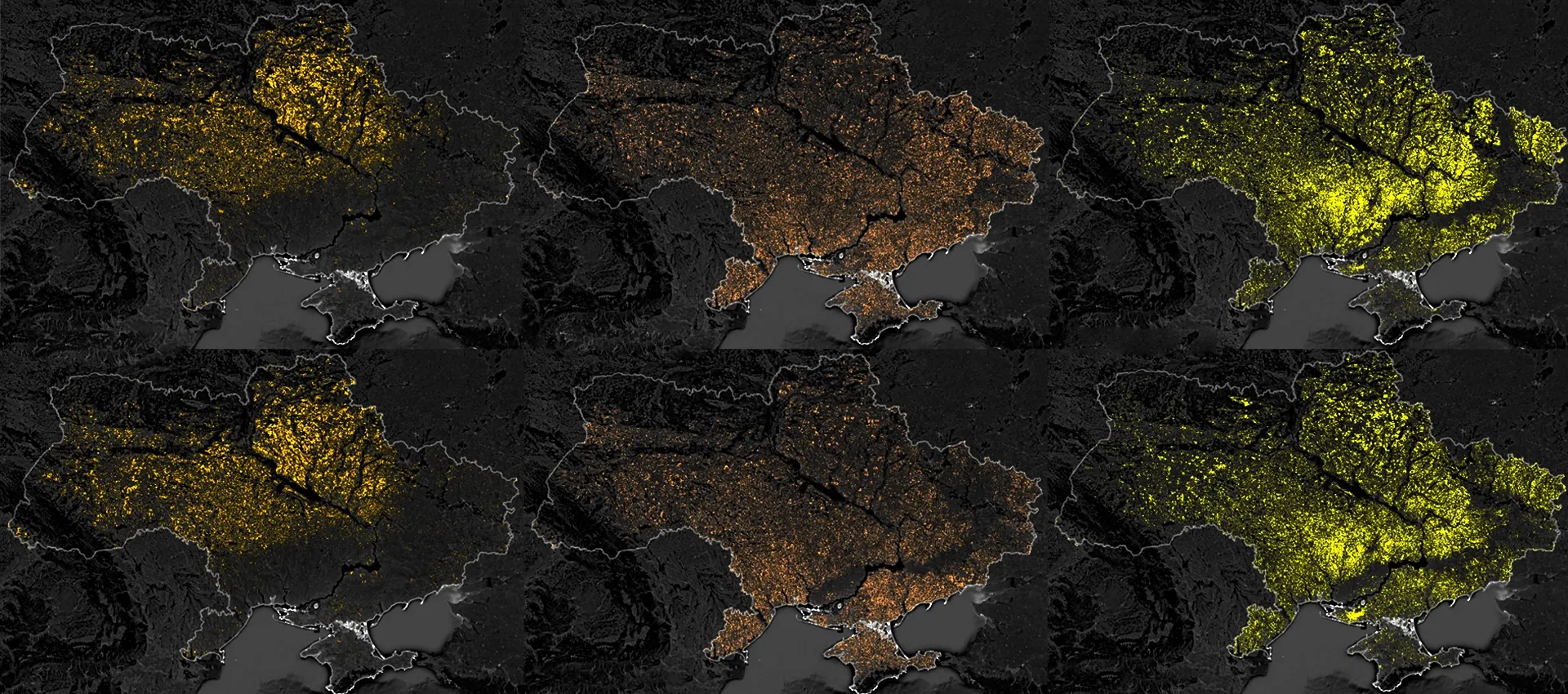
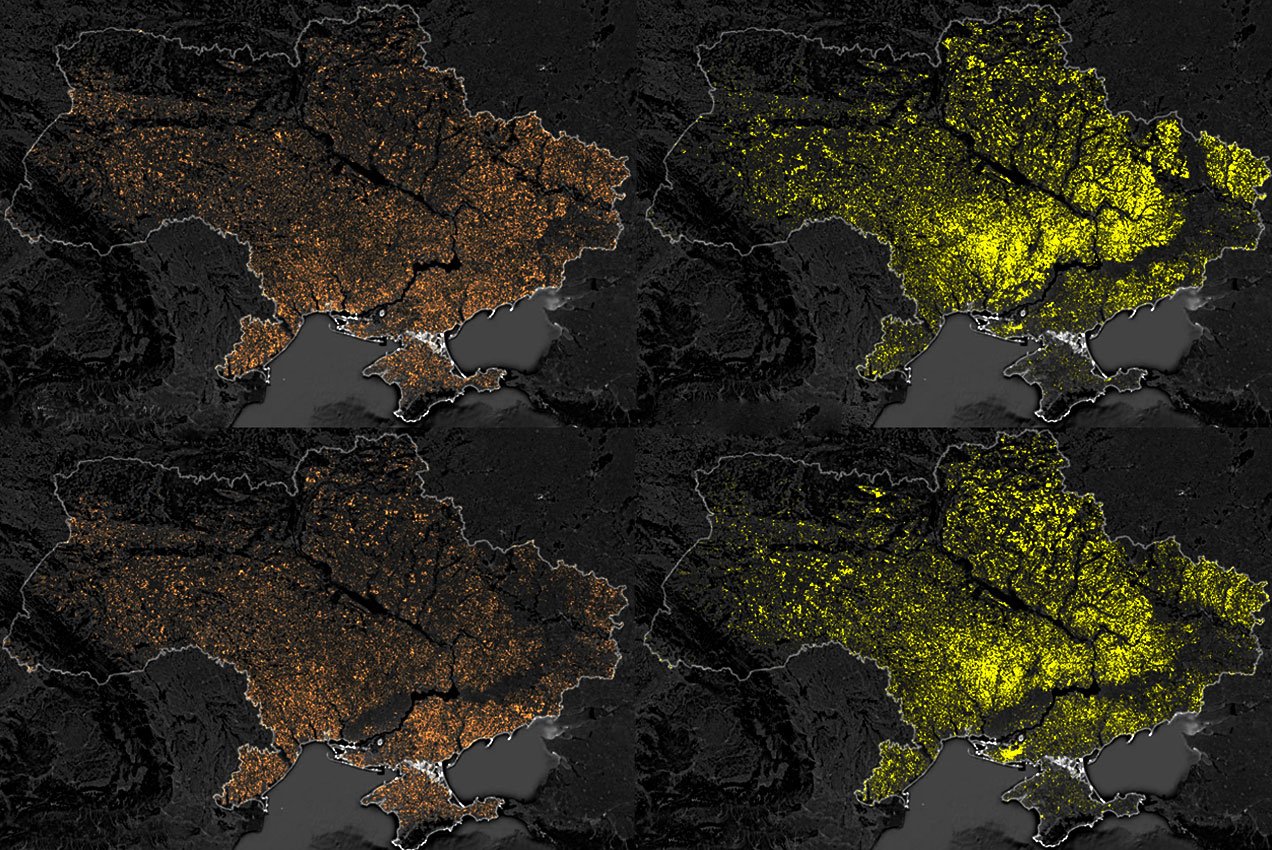
Harvest from
the occupied territories
How much Russia earns from the Ukrainian land
During the two years of the full-scale invasion, Russia has managed to harvest more than 10 million tons of wheat from the occupied territories. This is roughly equal to the annual output of an entire country, such a as Romania.
The material was prepared in partnership with TEXTY and agro-technology company OneSoil.
Читати українською
In the spring of 2022, the Russian occupiers confiscated or bought the remaining grain from Ukrainian farmers in the occupied territories for very low price. They also stole grain that remained in grain elevators and storage facilities. At that time, TEXTY investigated the main routes and importers of stolen Ukrainian grain, which often went to Turkey. However, as early as 2022, the Russians managed to sow the occupied lands. Although counteroffensive by the Armed Forces of Ukraine in late 2022 and throughout 2023 slightly reduced the size of the sown areas in the occupied territories, this year the Russians also harvested a considerable amount of grain from Ukrainian land.
OneSoil, a company that uses satellite imagery and machine learning to remotely identify the boundaries of fields and the crops grown on them, provided the data on wheat, sunflower, and maize acreage in the occupied territories to us.
These three crops are the most widely grown in Ukraine. As for the occupied territories, most of the sown areas are allocated to wheat and sunflower, according to OneSoil. Barley, rapeseed, and maize are sown in smaller quantities.
The machine learning model created for Ukraine by the company achieves a score of 0.93–0.96 out of 1. This is a high F1-score, a metric used to assess performance in classification tasks. Therefore, despite being unofficial, these data are trustworthy, as the model is trained on ground-truth data. More details about the algorithm are provided in a spoiler under the map. Without such information, we would not have been able to publish this project and show the industrial scale of Russian plunder.
The maps below show in colour the planted areas for 2021, 2022, and 2023 in the government-controlled and occupied territories of Ukraine for maize, sunflower, and wheat.
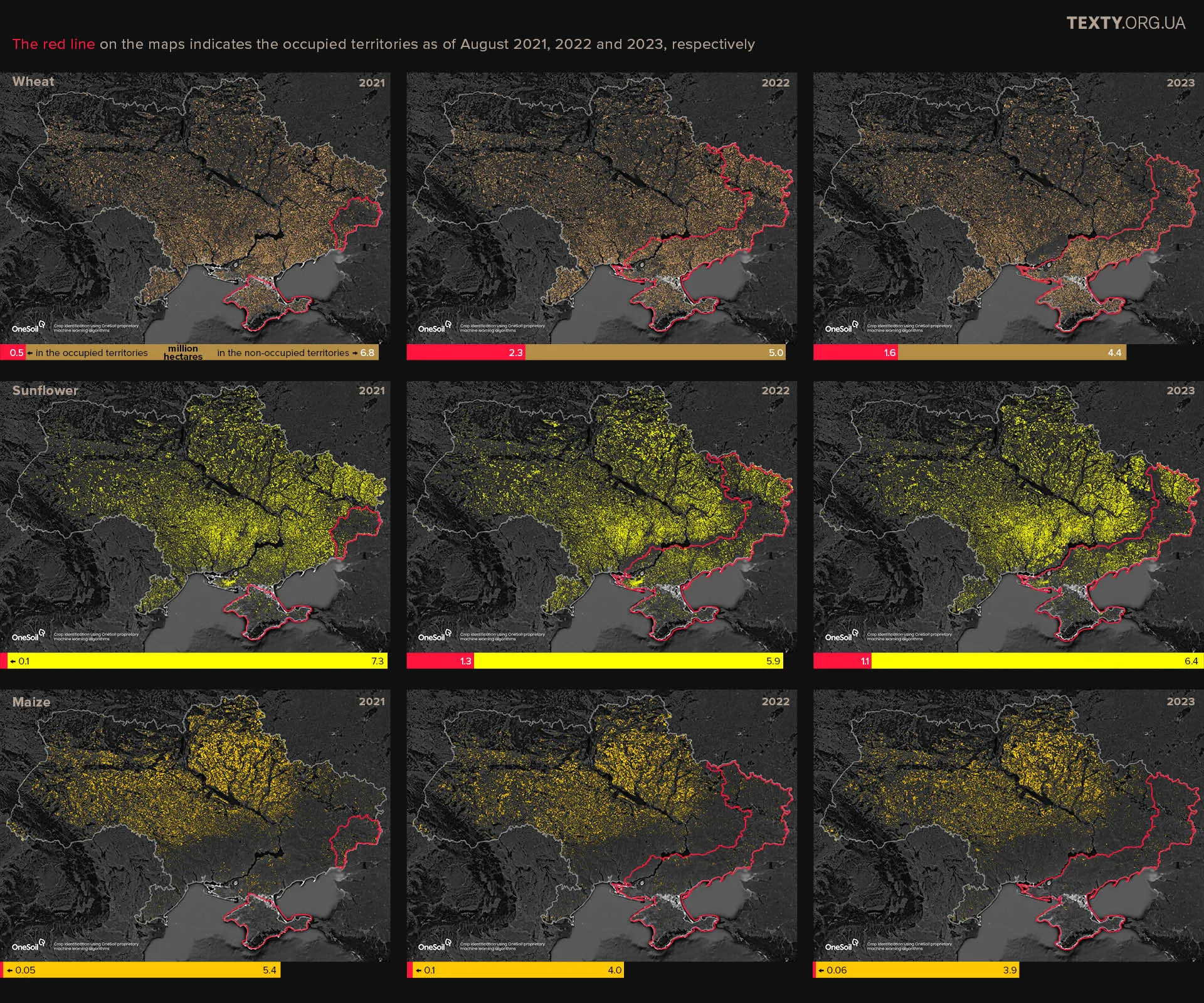
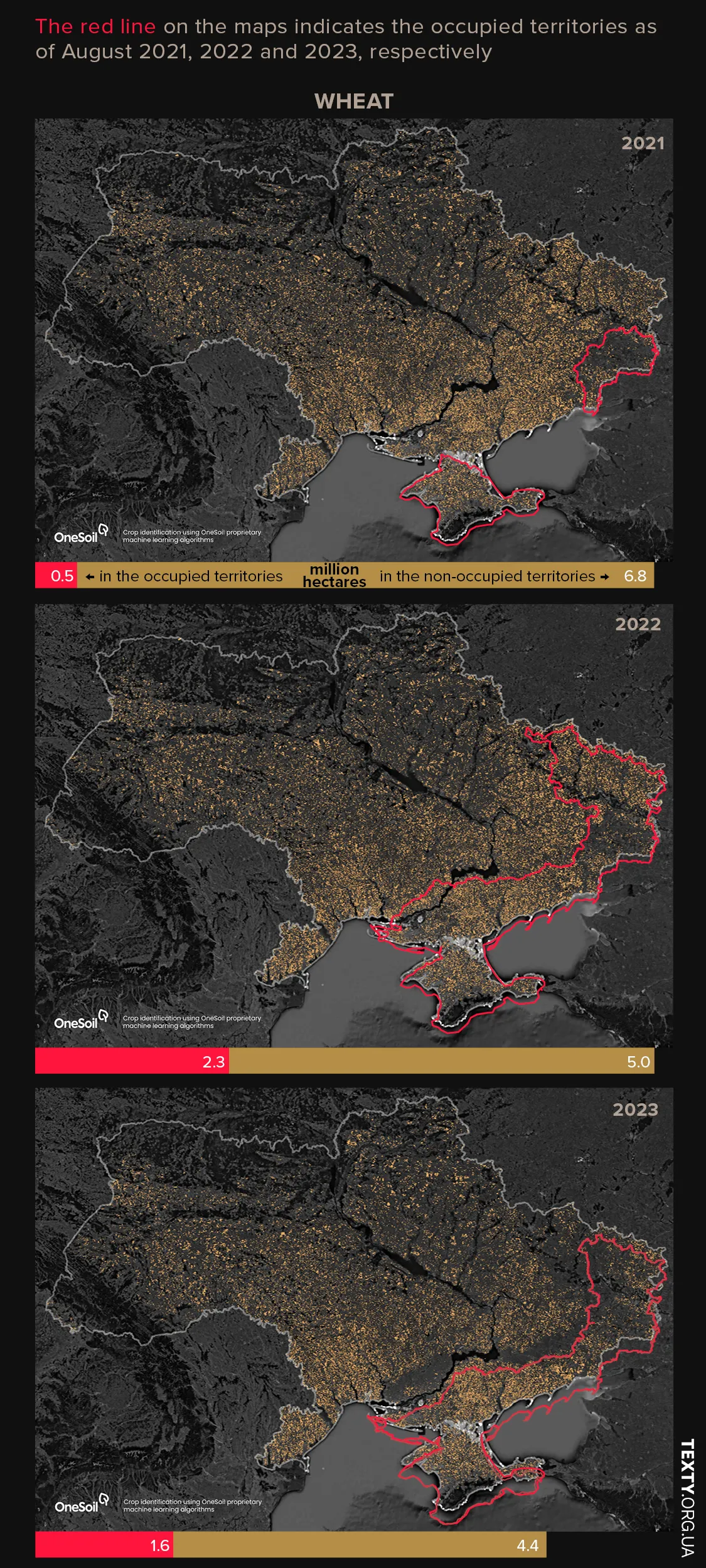
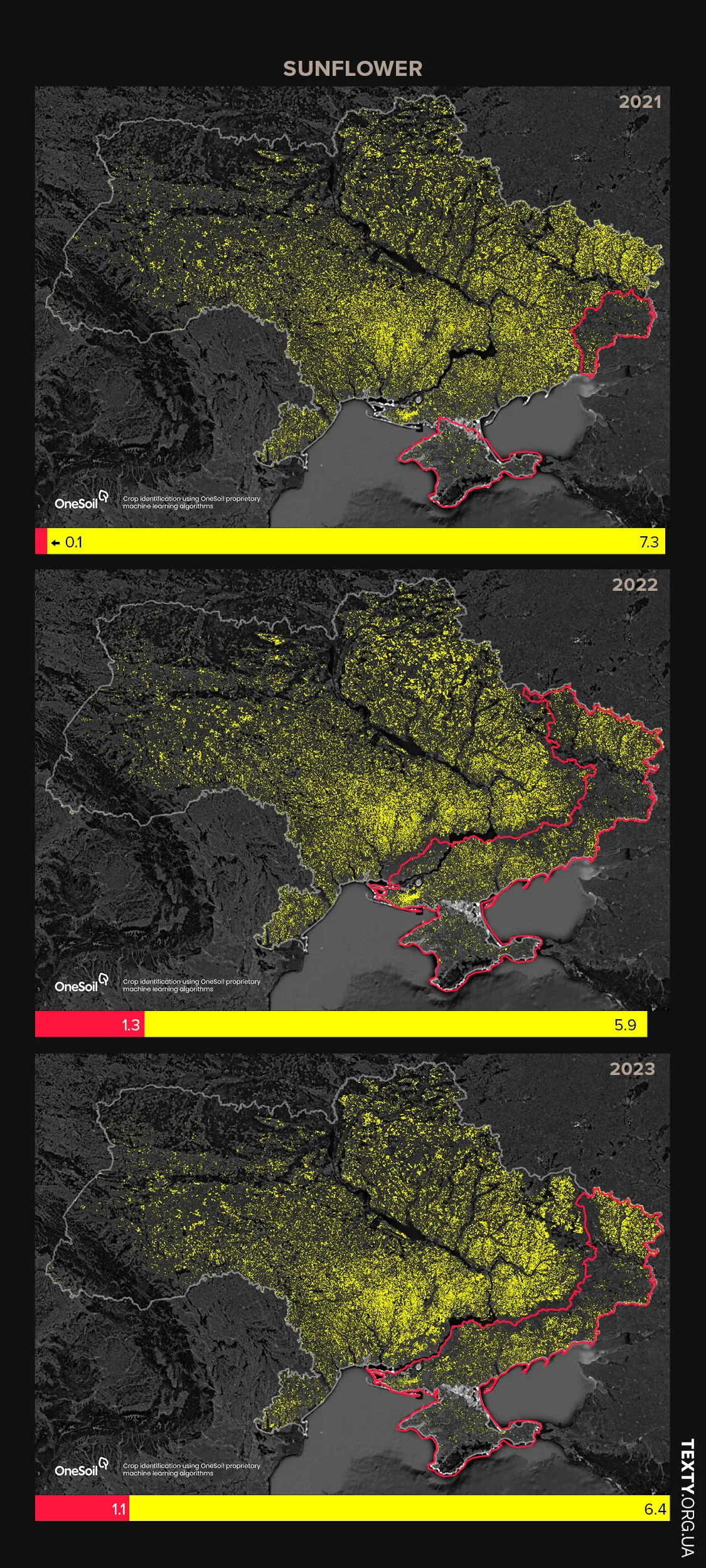
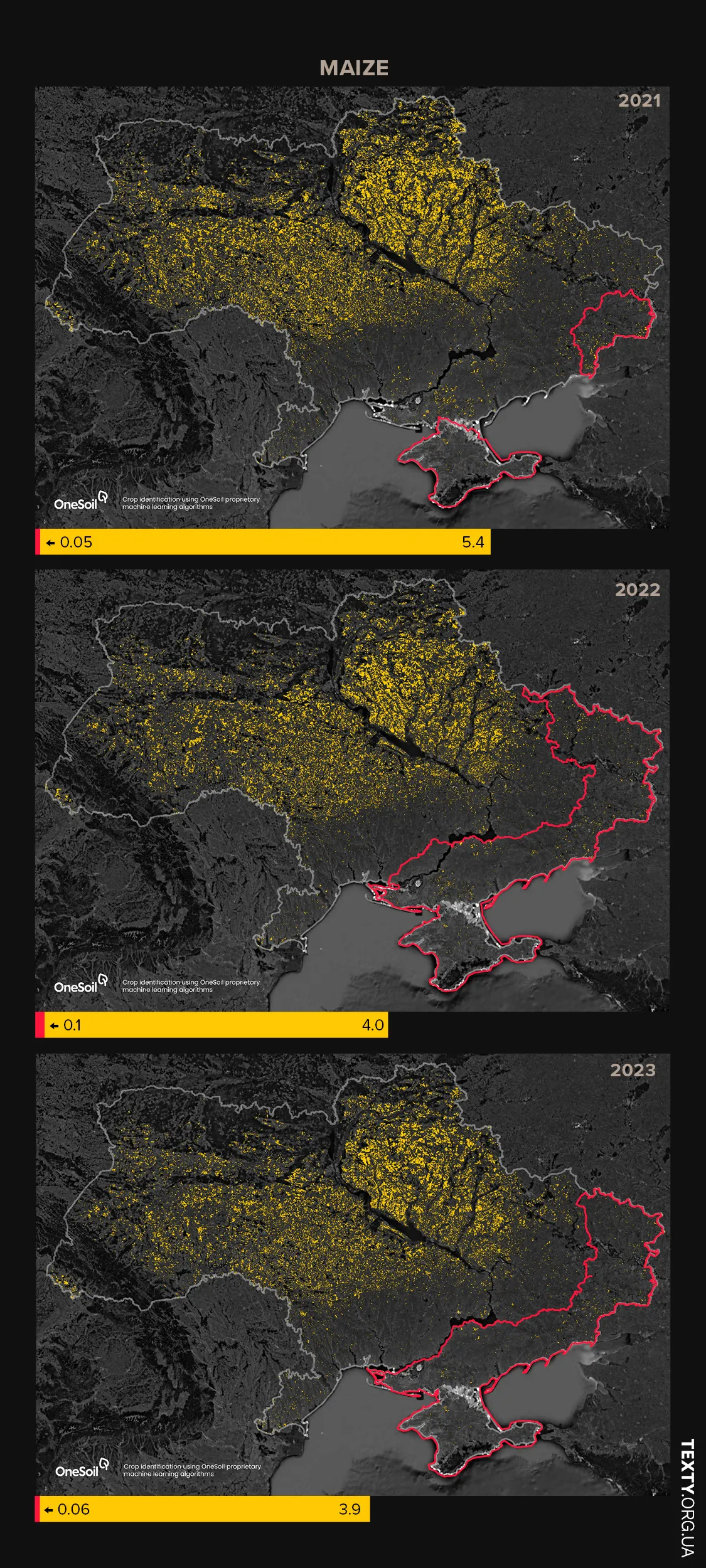
Thanks to OneSoil's active and ongoing cooperation with Ukrainian agricultural holdings and farmers, the company has reliable ground truth data on more than 3.5 million hectares of fields in Ukraine alone. This data is combined with data from users of the OneSoil app and information from open sources. Taking together, it forms the basis for AI models training.
The algorithm requires pre-processing of satellite data to work correctly: increasing the spatial resolution of raw images, detecting clouds, and accurately determining the growing seasons for each specific region around the world.
Information partners:



Lower yields
Due to the arid climate, southern Ukraine has never been among the leaders in terms of grain yields, but even so, before the occupation, Ukraine had an average of 3.5-4 tons of wheat per hectare in Kherson, Zaporizhzhia, and Donetsk regions (or 35-40 centners per hectare, as we used to count). According to Argus Media, in 2022, the wheat yield in the occupied territories was already 2.8 tons per hectare. This is not surprising, as the Russians have almost destroyed the irrigation system of the Ukrainian south. But as we can see, without it, yields are still possible, albeit significantly lower. For corn and sunflower, we calculated the yields based on the average yield of the region - corn is about 3 t/ha, sunflower is about 1.8 t/ha.
However, even with low yields, agriculture in the occupied territories in 2022-2023, according to very rough estimates, should have brought Russia about 15 million tons of grain from only three crops: wheat, sunflower, and maize, according to very rough estimates.
The approximate estimate of the harvested crop.

2021
2022
2023
Harvested crop,
thousand tons
Wheat
497
6 463
4 589
1 391
2 308
1 639
Sown areas in the occupied territories,
thousand hectares
Sunflower
2 349
142
2 006
1 114
1 305
255
Maize
The graph shows approximate data based on information about the area of sown fields and the approximate average yield.
118
191
156
52
352
64

2021
2022
2023
Harvested crop,
thousand tons
1 391
6 463
4 589
Wheat
Sown areas in the occupied territories,
thousand hectares
1 639
497
2 308
255
2 349
2 006
Sunflower
142
1 114
1 305
191
352
156
Maize
52
64
118
The graph shows approximate data based on information about the area of sown fields and the approximate average yield.

Harvested
crop,
thousand tons
Sown areas
in the occupied territories,
thousand hectares
1 391
497
2021
2023
2022
Wheat
1 391
497
4 589
6 463
1 639
2 308
Sunflower
255
142
2 006
2 349
1 114
1 305
Maize
156
191
352
52
64
118
The graph shows approximate data based on information about the area of sown fields and the approximate average yield.
Ukrainian farmers who remained under occupation are forced to sell grain for very low price. In the summer of 2022, Radio Liberty, citing the Main Intelligence Directorate of the Ministry of Defense of Ukraine, reported that in the spring of 2022, the Russian occupation forces made the population sell 70% of the harvest to buyers from the occupied Crimea. Moreover, purchase prices sometimes amounted to about 10% of the retail price. Later, it became even more difficult as Russian farmers began to harvest their own crop.
It’s interesting that in 2022, fields in both government-controlled and occupied areas were almost close to the front line. However, in 2023, due to the multilayer fortifications that the occupiers began to build to prevent a counteroffensive by the Ukrainian army, the line of agricultural land shifted significantly to the South, especially in Zaporizhzhia and Donetsk regions.
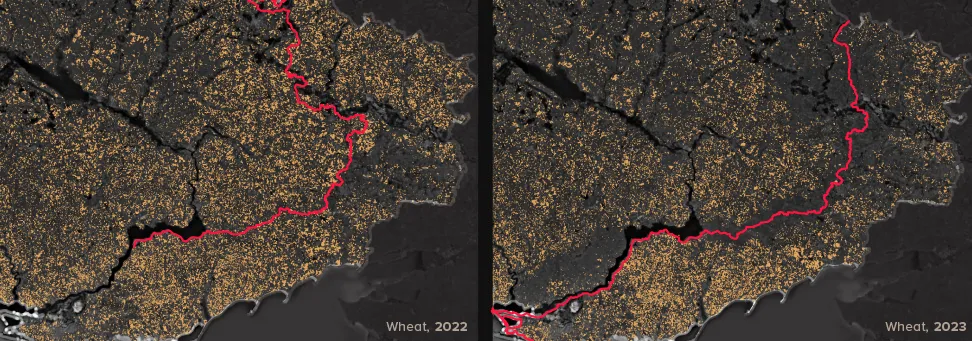
In the areas near the frontline, particularly in Orikhiv district, the occupiers even banned the sowing of tall crops such as sunflower and maize.
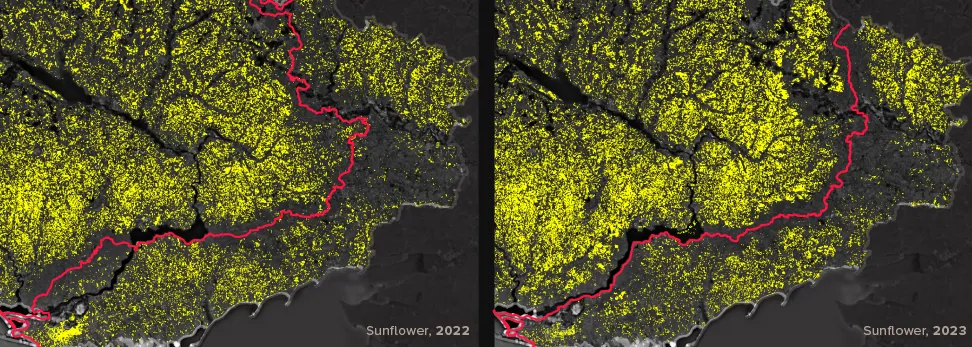
Queues of grain trucks in Crimea do not end
Despite the fact that parts of Kherson, Zaporizhzhia, Donetsk and Luhansk regions have been under occupation for two years, grain is still being exported, just as it was at the beginning of the full-scale invasion, mostly through Crimea or to cities of the Russian Federation.
Satellite imagery regularly shows huge accumulations of grain trucks near grain terminals in Sevastopol and Kerch.
We highlighted the trucks and wagons in these images to make it easier for you to find them.
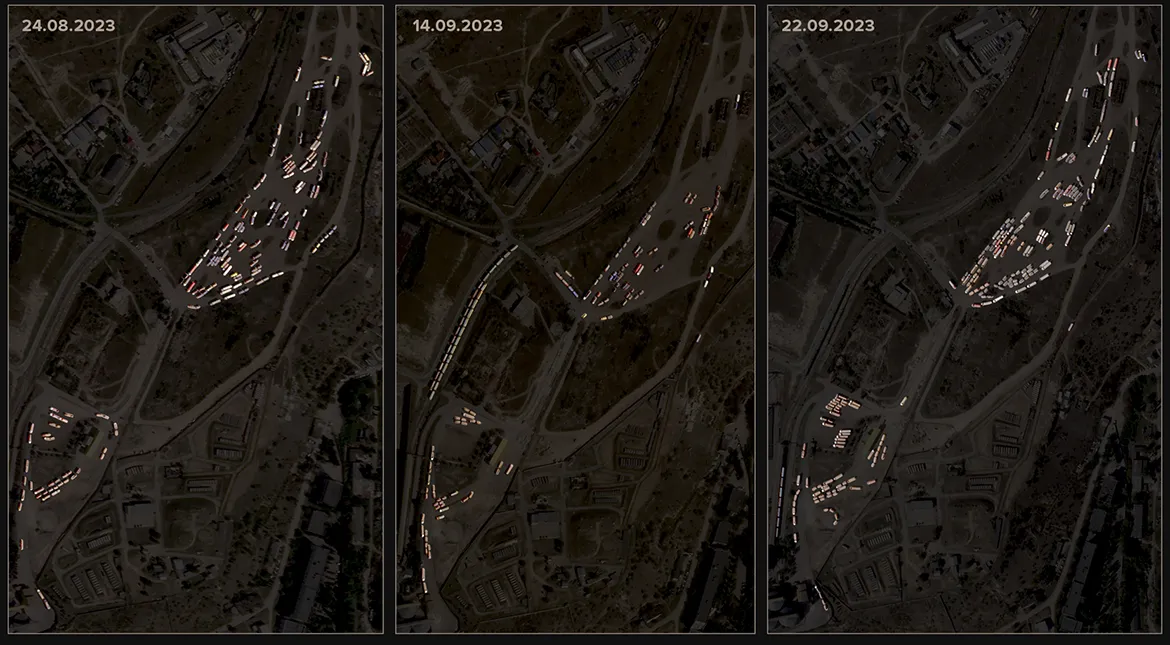
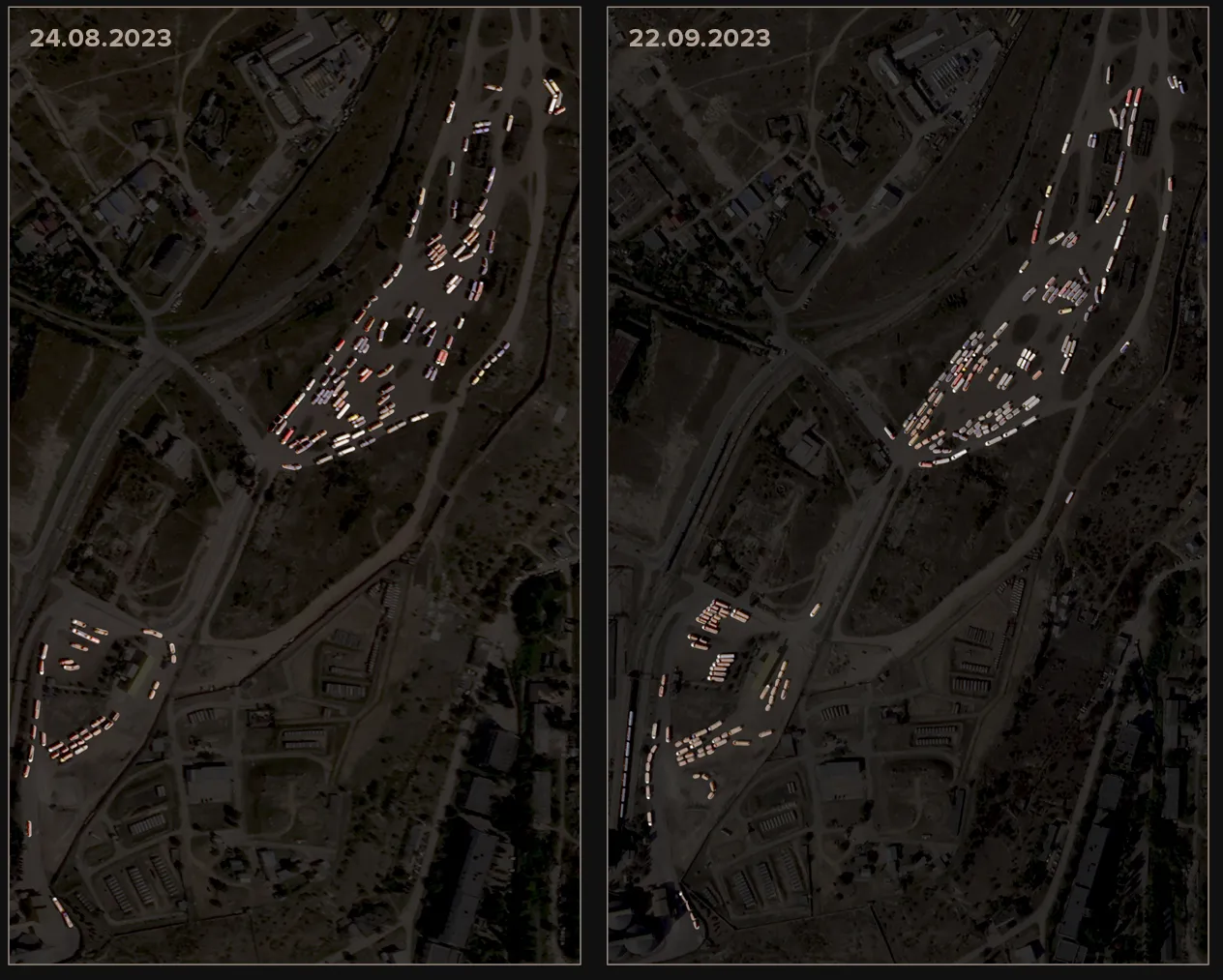
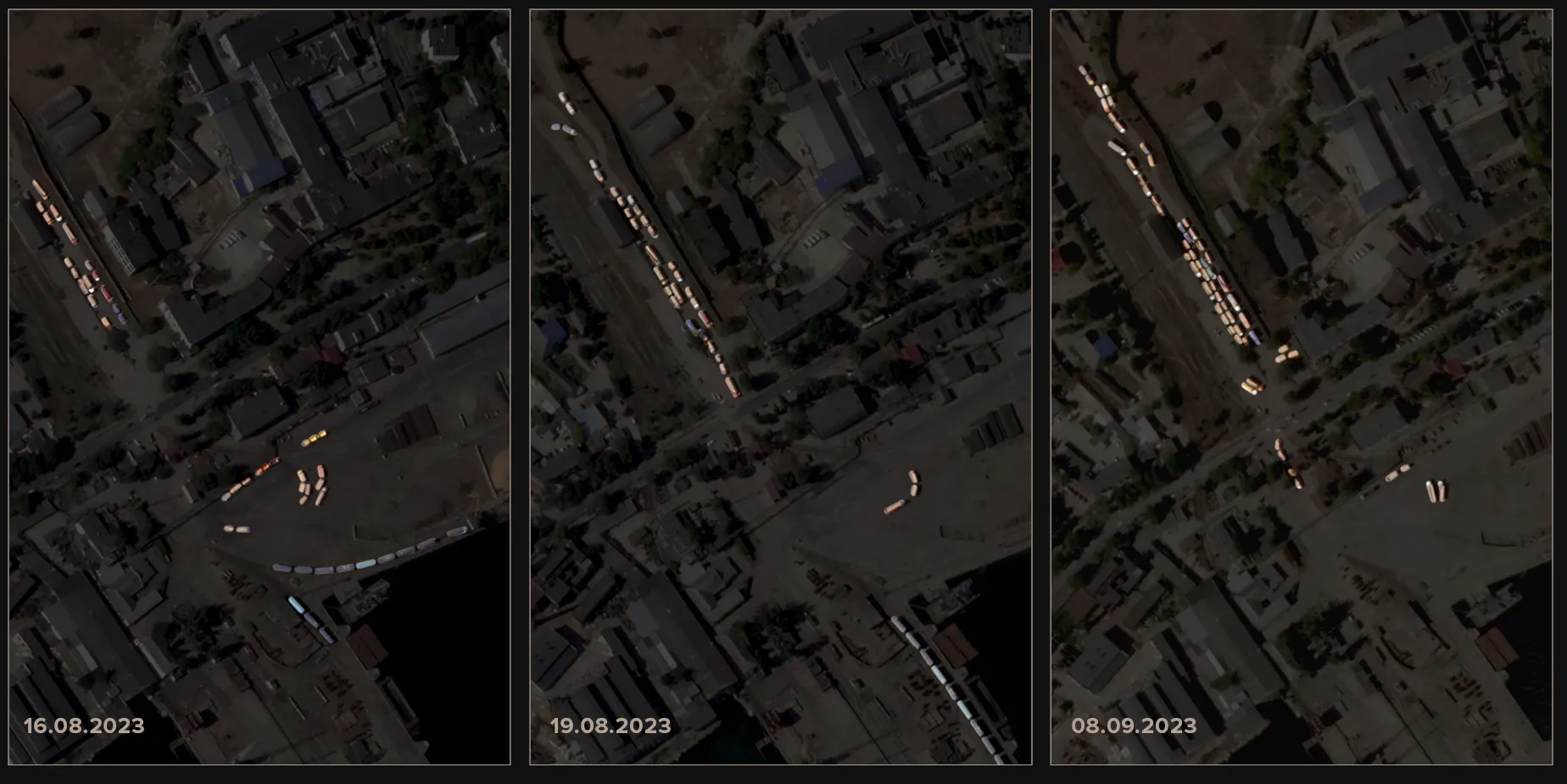
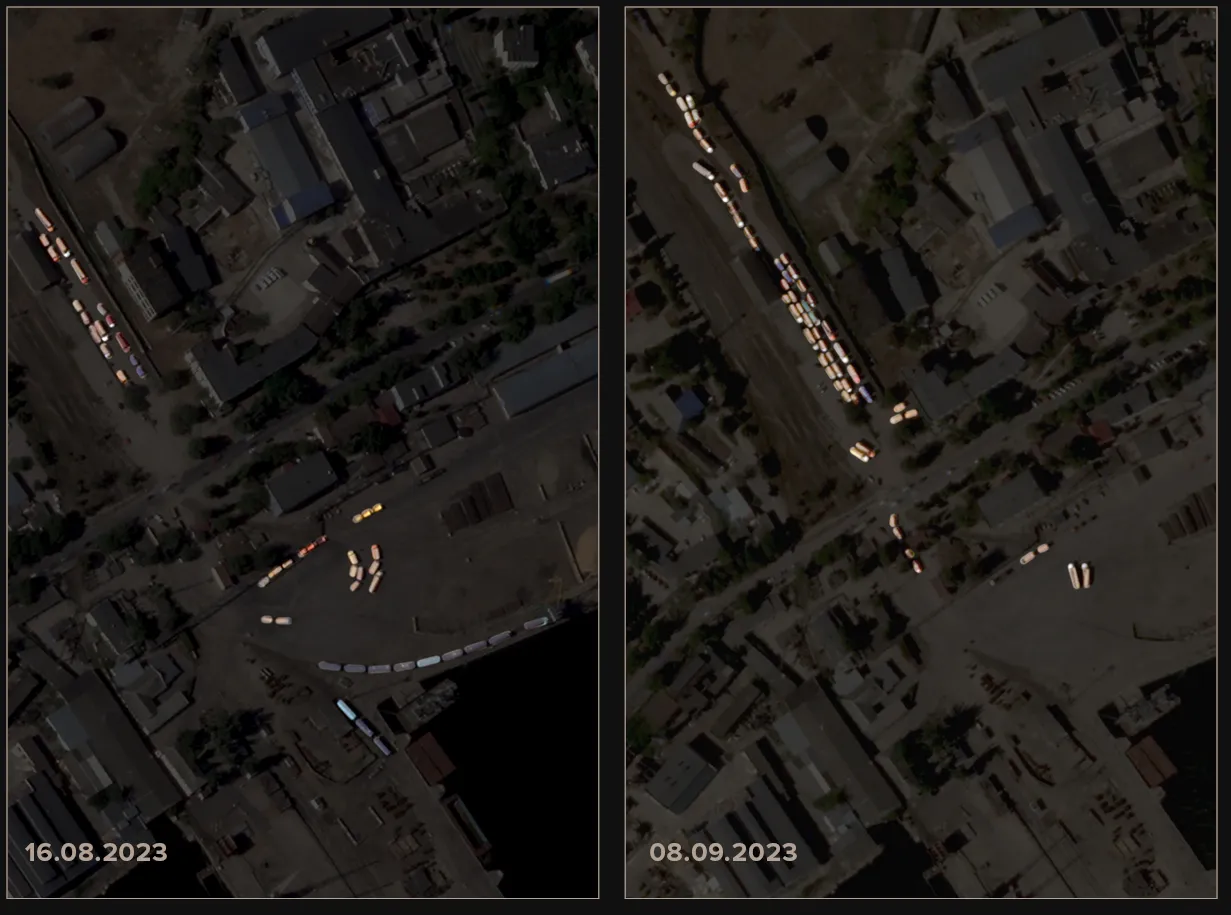
The reason for this is the well-established networks of buyers and well-established logistics chains. In addition, the ports of the peninsula have more capacity and have not been affected by the hostilities.
The ports of Berdiansk and Mariupol do not have similar accumulations of grain carriers, although the occupiers announce plans to significantly increase ports turnover and repair terminals. In 2022, Ukraine planned to launch a state-of-the-art grain terminal in Mariupol, but during the siege of the city, the Russians destroyed everything. It was only in the spring of 2023 that the occupiers reported (this link will take you to the Russian website, you may need a VPN to view the page) that the "first ship" with grain had left the port of Mariupol. At the end of October, the Russians estimated the port's cargo turnover (VPN) for 10 months of 2023 at 111 thousand tons, most of which is grain (VPN). This year, the occupiers also plan to start repairing the port in Berdiansk (VPN). For comparison, in the period from July 2020 to May 2021, grain exports (excluding processed products) from Mariupol and Berdiansk amounted to 2.3 million tons. The capacity of Agria's grain terminal in Berdiansk after its reconstruction in 2017 was 770 thousand tons.
On the avito.ru job search site, there are many ads for grain truck drivers, sometimes indicating the region of work, as in this ad.

Estimated earnings
Recently, Yevhenii Balytskyi, a collaborator of the Zaporizhzhia Regional Council, who was appointed by the occupation authorities as the so-called "governor" of Zaporizhzhia region, appealed to Patrushev for additional 600 rail cars (VPN) to export grain from Zaporizhzhia region.
Last year, representatives of the occupation authorities wrote about the huge queues of grain trucks to Crimea in their Telegram channels.
Russia exports grain from the ports of Crimea and sells it to other countries that are not averse to stolen goods. If we start from the above data on sown areas and estimated yields, we get the following figures.
Estimated income from grain exports, USD million.
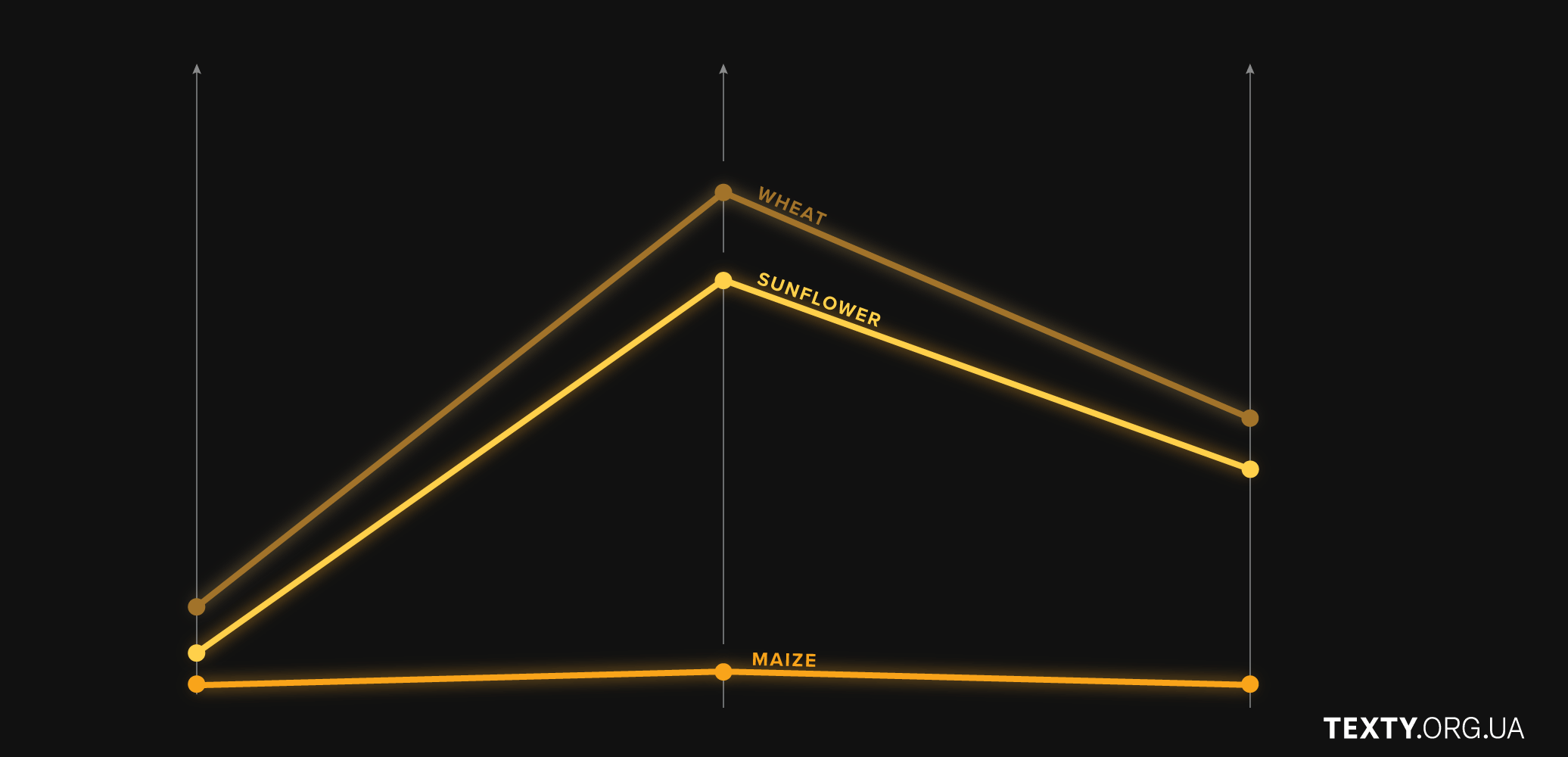
2021
2022
2023
2 269
1 873
1 248
1 017
The graph shows indicative data based on information about the area of sown fields, the approximate average yield and the export price.
395
103
187
41
42
Amount, mln USD
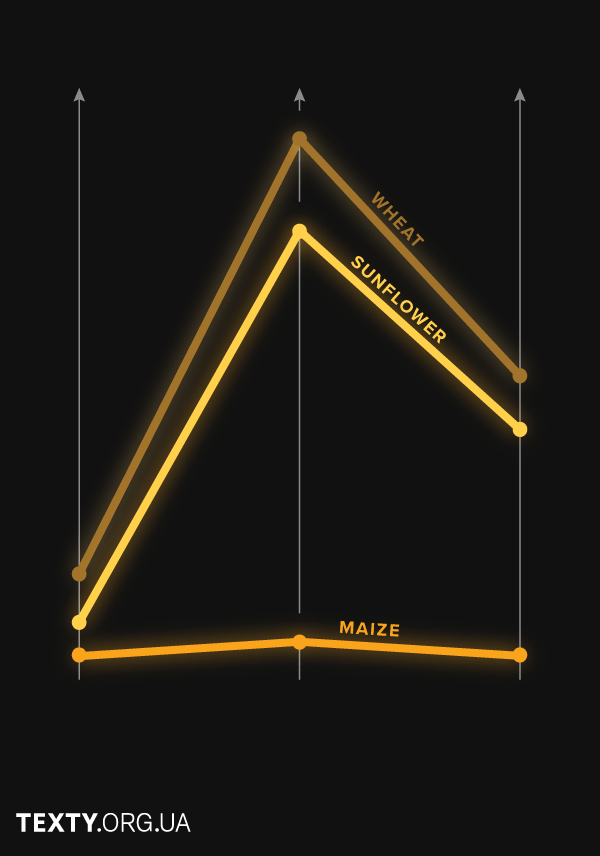
2021
2022
2023
2 269
1 873
1 248
1 017
395
103
187
41
42
The graph shows indicative data based on information about the area of sown fields, the approximate average yield and the export price.

2021
2022
2023
2 269
1 873
1 248
1 017
395
103
187
41
42
Amount, mln USD
The graph shows indicative data based on information about the area of sown fields, the approximate average yield and the export price.
We asked many experts to provide us with indicative data on prices or revenues of the Russian Federation from the export of Ukrainian grain, but none of them agreed to talk about the problem, citing a lack of data.
Therefore, we assumed that the grain grown on Ukrainian land would be exported and we relied in our calculations on the export prices of the Moscow Exchange.
The website's historical data includes prices for wheat, corn, sunflower oil, and sunflowermeal. We took corn and wheat prices as they were. The cost of sunflower was calculated based on the cost of sunflowermeal and sunflower oil and the ratio of 0.4 tons of sunflower oil and 0.6 tons of sunflowermeal per 1 ton of grain. We multiplied the estimated cost by the approximate yield based on the yield calculator for the occupied regions. However, if we found additional, more accurate information on yields or values, we relied on it. As it was in the case of information from Argus Media that in 2022 the wheat yield was 2.8 t/ha in the occupied territories.
Theoretically, for every ton of exported grain, an export duty is paid directly to the budget of the aggressor country. Its part changes weekly and depends on the indicative grain prices approved by the Russian Ministry of Agriculture. As of December 2022, the export duty on wheat, for example, was $61.7 per ton, and as of November 1, 2023, it was slightly more than $52, according to the ruble-dollar exchange rate. The export duty on sunflower in Russia from August 2022 to August 2023 was 50% of the cost, but not less than $320.
The rest of the money, even if it doesn't go directly to the budget, still feeds the Russian economy by covering logistics costs, salaries, etc. and simply enriches Russians.

